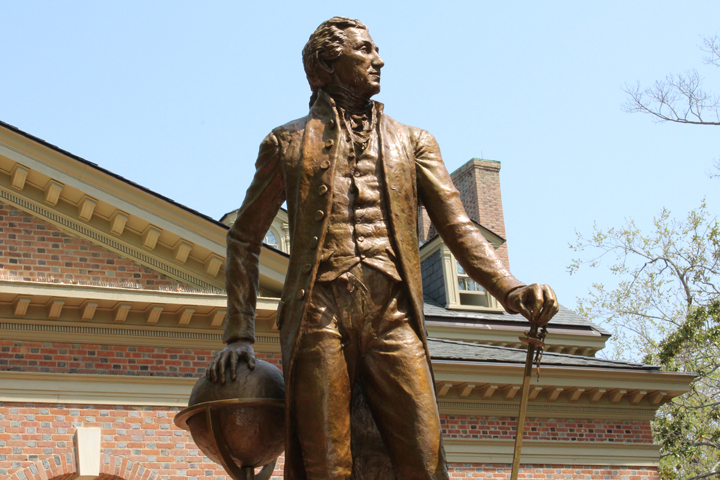The Monroe Doctrine 2.0?
December 23, 2023 | Expert Insights

Statements are echoing in the corridors of power in Washington that, in one form or the other, the Monroe Doctrine is experiencing a revival.
This time-hallowed foreign-policy doctrine underscores Washington’s determination to act as a bulwark against political and military incursions into the Western Hemisphere by powers outside of it. Has the war in Ukraine and the rise of China triggered this strategic debate?
Background
The Monroe Doctrine had its origins in a speech by President James Monroe to Congress in 1823, where he pointed out that the Old World and the New World were essentially different and should be kept as separate spheres of influence. The United States would refrain from interfering with European affairs or even existing European colonies in the Western hemisphere. In turn, European powers were warned not to attempt further colonisation or military intervention in the Western Hemisphere. The United States would view any attempt by a nation outside the hemisphere to exert its power or influence in the hemisphere as a potential threat to its security.
The contextual backdrop was that by the early 1820s, several Latin American countries had won their independence from Spain and Portugal. The U.S. government recognised the new republics of Argentina, Chile, Peru, Colombia, and Mexico in 1822.
However, Britain and the U.S. were concerned that European powers would try to re-establish colonial rule in the region. Russia had added to this concern with Czar Alexander I claiming land in the Pacific Northwest and forbidding other countries' ships from approaching it.
With the Monroe Doctrine, the U.S. would step into a new role as a protector of the Western Hemisphere. From 1870 onward, as the United States grew economically and militarily, it justified several U.S. interventions in Latin America with the doctrine.
Under President Theodore Roosevelt’s expansive interpretation, it gained the “Roosevelt Corollary” or the “Big Stick” policy wherein its scope included the U.S. acting as an “international police power”, intervening in cases of “flagrant wrongdoing” in Latin America. This was used to justify military interventions in Central America, the Caribbean, the Dominican Republic, Nicaragua, Haiti, and Cuba.
Although this stance was subsequently softened with treaties signed during and after World War II for cooperation between North and South America, the doctrine persisted.
It was invoked by U.S. presidents during the Cold War and leading up to the 21st century to justify interventions such as in El Salvador and Nicaragua. While the U.S. reduced its military involvement in the region at the start of the 21st century, it continued to exert influence over its affairs.

Analysis
The Monroe Doctrine seems to be making a comeback in the U.S. Rex Tillerson, Donald Trump's secretary of state, upheld its relevance as far back as 2018. More recently, several Republican candidates have called for a modern revival of the doctrine to counter growing Chinese influence in Latin America. China has been a causative factor, as mentioned by Governor DeSantis, who called for a '21st-century version' to face up to the Chinese.
The fear in Washington is not just perceived; since 2001, Beijing has significantly increased its presence in Latin America with leaps in trade and investment. Chinese state firms are major investors in the region's energy, infrastructure, and space industries. China has surpassed the U.S. as South America’s largest trading partner. Most recently, it expanded diplomatic ties during the COVID-19 pandemic by supplying the region with medical equipment, loans, and millions of vaccine doses.
Political and military engagements (including arms sales) have grown between Beijing and countries like Venezuela, Ecuador, Bolivia, and Argentina. These political, military, and trade ties with China often undermine U.S. attempts to exert its influence in the region, particularly against regimes it does not favour. For example, Venezuela has been the region's leading buyer of Chinese military hardware since the U.S. banned commercial arms sales to Venezuela in 2006. Argentina, Bolivia, Ecuador, and Peru have bought Chinese military aircraft, ground vehicles, air defence radars, and assault rifles, amounting to millions of dollars. Additionally, China lent substantial financial support to the socialist regimes of Hugo Chávez and Nicolás Maduro in Venezuela, as well as socialist regimes in Ecuador, Bolivia, and Argentina.
Russia is also keen to build its influence in the region, particularly due to its political and economic isolation since its invasion of Ukraine, but also to counter U.S. pressure and NATO expansion in Eastern Europe. With Cuba as an entry point into the Western Hemisphere, Moscow is looking to gain access to nations like Venezuela, Nicaragua, Argentina, and Brazil.
Naturally, the U.S. is not amused by these forays of its rivals Beijing and Moscow into its neighbourhood and security perimeter, just as Moscow is touchy about NATO expanding near its borders.
However, it is not all smooth sailing for Beijing in Latin America. It is worth noting that several right-wing leaders in South America are anti-China, such as former Brazilian president Jair Bolsonaro and new Argentine President Javier Milei. These leaders have looked to the U.S. to counter China’s economic and political influence.
The U.S. fears that Beijing is looking to further geopolitical interests like isolating Taiwan and supporting authoritarian regimes in the region. The number of Latin American countries supporting Taiwan has been dwindling, and recently, Taiwan lost recognition of Panama, the Dominican Republic, El Salvador, Nicaragua and Honduras. This is hardly surprising considering that Beijing has invested over $130 billion in the region between 2005 and 2020. Paraguay remains the last man standing, and pressure is already growing internally to veer towards Beijing.
U.S. President Joe Biden has promised greater economic cooperation with Latin America, but many argue that the United States should do more to bolster its presence in the region.
While invoking the doctrine may gain domestic support and resonance amongst Republican nationalists, it will not please Latin America. Gone are the days of gunboat diplomacy, and unless Washington hangs out a large enough financial carrot, Latin American countries will continue to cooperate with China/ Russia.
The doctrine carries too much history of U.S. military interventionism and shady political interference and is understandably not looked upon favourably in Latin America. Few have forgotten the CIA-sponsored 1973 coup in Chile that replaced President Allende with a military junta led by General Pinochet. Allende was assassinated in the process, and a harsh military rule was imposed for the next 16 years.
U.S. warnings to South American nations about China are often looked upon as echoing the Monroe Doctrine and stemming from the paternalist policy that the U.S. knows what’s best for the region. They seem to find little resonance these days.
Assessment
- The Monroe Doctrine offers a tempting solution as the U.S. looks for a coherent approach to deal with its neighbourhood concerns. Its simplicity, persistence over time, and nationalistic resonance make it a viable approach to prevent Beijing and Moscow from extending their influence closer to the U.S. backyard.
- A rallying point for Republican nationalists and a contentious debate in domestic politics, the doctrine may not help the U.S. garner credence in Latin America. Rather than countering Beijing, it might push South American nations further away from the U.S., given the doctrine’s history of interference and lack of respect for Latin American nations’ independent foreign policy.
- Mere rhetoric does not work in these days of social media. If it has to effectively counter Chinese economic influence in its backyard, Washington will have to pursue a deeper rationalisation of financial relationships, including trade-friendly overtures to the countries in the Western Hemisphere. Lesser corrosive solutions will have to be found, preferably in alliance with its democratic partners.








Comments